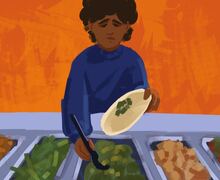SU’s 1st Indigenous healer discusses cultural meanings of Full Moon Ceremony
Meghan Hendricks | Assistant Photo Editor
November’s Full Moon Ceremony will be held on the Quad, but in the case of inclement weather will be moved to Hendricks Chapel.
Get the latest Syracuse news delivered right to your inbox.
Subscribe to our newsletter here.
At last month’s Full Moon Ceremony, participants stayed for almost two hours, an hour past the event’s scheduled end time. This month’s iteration of the ceremony, which Diane Schenandoah called “a beautiful time just to take pause and to give thanks,” will take place on Friday.
Normally, the event does not include drums and singing, but Schenandoah, Syracuse University’s Honwadiyenawa’sek (the one who helps), has added these elements to the event — which is held on the Quad — since it has more of a celebratory atmosphere in light of November being Indigenous Heritage Month, she said.
Schenandoah will host November’s Full Moon Ceremony on Friday evening at 6:30 p.m. All SU community members are welcome to attend, she said. While drums and other percussion-like instruments will be provided, she encourages participants to bring their own as well.
The monthly event is scheduled to happen outdoors on the Quad, but in the case of inclement weather, it will happen inside at Hendricks Chapel. On Tuesday afternoon, The Daily Orange interviewed SU’s Honwadiyenawa’sek about the Full Moon ceremony on Friday and the importance of the tradition. The interview has been edited for clarity and brevity.
The Daily Orange: What is the significance of the Full Moon Ceremony to you?
Diane Schenandoah: The full moon comes every month and we call her grandmother. It is very important that we give thanks for all things that Grandmother Moon controls: cycles of women, the tides in the ocean, the seasons for planting, and she determines when children will be born. So Grandmother Moon does so many things for being here on Earth that it is important that we give thanks. Give thanks to her continuing her duties because she believes that all life forms here on Earth are given a duty. We were given a duty, and we need to be thankful for all things.
The ceremony was brought to my family probably over 30 years ago, but I know a lot of different communities do this Full Moon Ceremony. And before it was brought to my community, it was from the Ojibwe people, and that’s kind of how we conduct this ceremony here on campus.
The significance of (Full Moon Ceremony) is to replenish yourself and to remind yourself that we are part of a bigger universeDiane Schenandoah, SU's first Indigenous healer
The D.O.: Can you describe what you grew up doing in your family’s Full Moon Ceremony?
DS: What we do, and again, I say what I do is from the Ojibwe Nation, we pass around the tobacco and everyone puts in their good thoughts and prayers of what they’d like to pray for and what they are thankful for. If you want to pray for individuals or family members or community members or nations — we pass the tobacco around — and everyone gets the opportunity to say what they’d like to pray for. And then normally, we burn the tobacco there and we say that it’s our sacred tobacco that carries our prayer to the Creator.
For the burning of the tobacco, I usually take it home, and I burn it in my home. The important part is that the people at the ceremony put their prayers in the tobacco, and I take care of burning it and praying with the tobacco.
Then we go around the circle and we say what we are thankful for. We bring out the water, and we pass around cups of water in the counterclockwise direction that the Earth moves. And we say why we’re thankful for water, because we need clean water. And normally we end with hugging one another or going around and shaking each other’s hands. But the hug is kind of a more loving way to complete the circle. And then, here on the Quad, we included some social singing and social dancing.
The D.O.: Do you have a fond memory tied to the Full Moon Ceremony? Is there a part of it that you feel particularly connected to or that that you look forward to?
DS: It’s a whole family process and a time to give thanks to a particular element that watches over the nighttime skies. A particular element we call grandmother. The last Full Moon Ceremony on Oct. 20 was set to last half an hour, and it went on for about two hours. It was a lot of fun, and everyone enjoyed themselves. It’s really a beautiful time just to take pause and to give thanks.
The D.O.: What is the importance of the Full Moon Ceremony to students, faculty and staff members?
DS: The significance of it is to replenish yourself and to remind yourself that we are part of a bigger universe. We are part of certainly something larger than we are. We all need each other. We all need to give things for each other, and it’s time we take to pause and thank Grandmother Moon for continuing her duties because as human beings we all have duties here. We all have things that we need to take care of in our lives. We need to look out for one another. We need to account for our communities. You know, we need to call her Mother Earth. So this is kind of our small way every month to give thanks.
The D.O.: And for students who have never attended before, what can they expect, and is there anything that they can kind of come prepared with to the Full Moon Ceremony?
DS: It’s important that the Syracuse University community, including the staff and faculty, are welcome to join in. Participants are welcome to bring drums, and the singing and dancing part we just kind of added on here. Normally, we don’t have dancing and singing at the end of the ceremony, but it’s important that we included it because it is a celebration when we pay honor to the Grandmother Moon, and it kind of turned into a celebratory event.
Really it is just that time to just take that pause to say thank you. Thank you for continuing her duties. We’re so busy in our daily lives that we really need to stop and just pay our gratitude to the elements that continue to take care of us. The thunders, the rains, the plant life, animal life and fish life. How often do we stop and just say thank you?
Published on November 17, 2021 at 11:08 pm
Contact Louis: louis@dailyorange.com | @JBL__98






